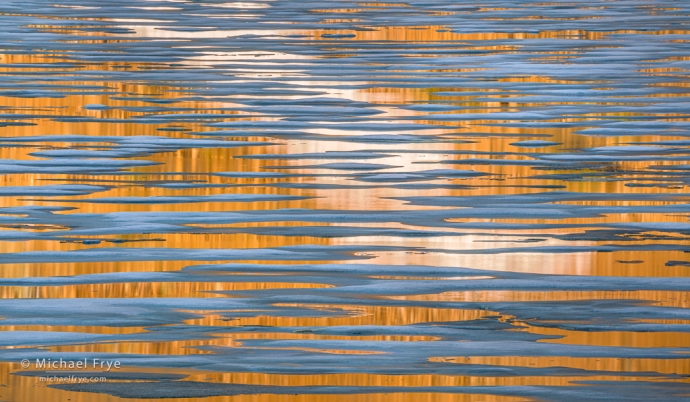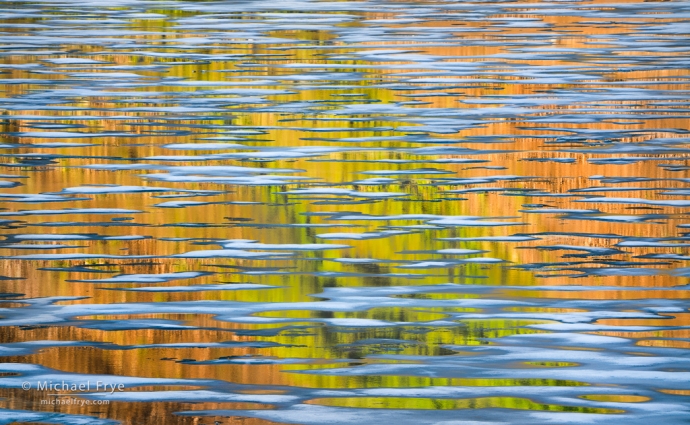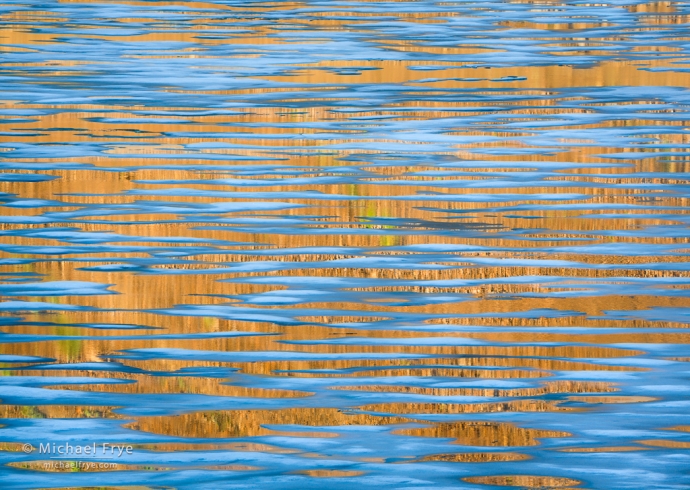Claudia and I love going up to the Yosemite high country in summer. But we hadn’t been able to get up there because the Tioga Road opened so late. We’d been over to the eastern side of the Sierra a couple of times (via Sonora Pass), and we were even able to get up to the top of Tioga Pass from the east side on the last day of our Range of Light workshop. But we hadn’t seen Olmsted Point, Tenaya Lake, or Tuolumne Meadows since last summer, which felt strange.
Tioga Road finally opened on July 22nd, by far the latest opening date ever. And two days later Claudia and I headed up and over the pass. It was great to see our familiar high-country haunts again, with lots of water in the meadows and creeks, and flowers beginning to bloom. We kept remarking on how everything is happening so late this year – at least a month later than usual.
I was hoping we might still find ice in one of the high-country lakes – and we did, though it was melting quickly, and probably gone the next day. I love photographing melting ice, as it can have great patterns, and wonderful colors in the right light. To me, the best light happens when the ice is in shade, bringing out its blue tones, but the water in between patches of ice reflects the colors of a sunlit mountainside.
That’s almost always the most interesting light for reflections – water in shade, reflecting something in the sun. It’s something I look for all the time. Even on a sunny day, with no clouds, that situation can create wonderful opportunities. You can see some examples of this light in my top photographs of 2022: especially #37, which received the second-most votes, and #12, which received the seventh-most votes. And #25 (third-most votes) and #28 (ninth-most votes) show sunlit clouds reflected in shaded water.
So upon finding the ice, I waited for the sun to dip behind a ridge and throw the lake into shade. I knew sunlight would still hit the mountainside on the far shore of the lake for awhile, creating colorful reflections in the shaded water.
The ice was some distance across the lake, so I would need a long lens to zero in on it. Pattern photographs usually work best when you can fill the frame with the pattern, from edge to edge, and make it look as if the pattern extends beyond the frame indefinitely. I could have walked around the lake to get closer to the ice, but that wouldn’t be the right angle to get the sunlit mountainside reflected in the water.
So I pulled out my 100-400mm zoom, and extended it to 400mm for all these photographs. And luckily I found a knoll near the edge of the lake, allowing me to gain some elevation and see the patterns; at lake level I would only have seen the ice edge-on, without the patterns of open water in between the patches of ice.
I also used a small aperture (f/16) to try to get all the ice in focus; even then I had to focus stack and blend two frames together for each composition. The thin layers of ice were actually moving most of the time, blown by the wind, so I used Photoshop to manually blend the two-frame stacks together.
I’ll probably never again photograph melting ice in the Yosemite high country so late in the summer. But it’s always a treat, whenever I find it.
— Michael Frye

Melting Ice #3. 400mm, 2 seconds at f/16, ISO 100, two-frame focus stack blended in Photoshop. I used a seven-stop ND filter to get a slower shutter speed and smooth the ruffled water.
Related Posts: My Top Photographs of 2022; Photographing Reflections: Beyond the Mirror; From the Archives: Redbud Reflection
Michael Frye is a professional photographer specializing in landscapes and nature. He is the author or principal photographer of The Photographer’s Guide to Yosemite, Yosemite Meditations, Yosemite Meditations for Women, Yosemite Meditations for Adventurers, and Digital Landscape Photography: In the Footsteps of Ansel Adams and the Great Masters. He has also written three eBooks: Light & Land: Landscapes in the Digital Darkroom, Exposure for Outdoor Photography, and Landscapes in Lightroom: The Essential Step-by-Step Guide. Michael has written numerous magazine articles on the art and technique of photography, and his images have been published in over thirty countries around the world. Michael has lived either in or near Yosemite National Park since 1983, currently residing just outside the park in Mariposa, California.











Brilliant!
Thanks April!
Beautiful images!
Thank you Judy!
Magnificent color abstract! Wish I was there.
Thanks Randy! Maybe next year?
Beautiful images, Michael, thanks! Yes, they are wonderful color abstracts as Randy says. I drove over Sonora Pass this morning and there were still beautiful wildflowers. We’ll see how my images turn out. Take care.
Thanks Bob! Hope some of your wildflower photos turn out well.
A great collection of photographs, Michael. I wish I could have been there too!
Thank you Rob! Maybe next year…
I’m a big fan of water abstracts. These are wonderful Michael!
Thank you Tom!
Michael:
Those are wonderful images you made!
I love finding these abstractions and patterns in nature, but I have to remind myself to look at the scene, not as the objects they really are, but as textures, patterns, and colors.
Also I have replaced my 70-200mm with a 100-400mm, as it helps me abstract the scene in front of me by giving me the ability to isolate bits of pieces of the landscape.
Thanks Greg! And I’m glad you’re learning to see abstractly, as that’s such an important part of composition. For what it’s worth, I have both a 70-200 and a 100-400. the 70-200 (f/4) is a nice, light alternative when I’m hiking.